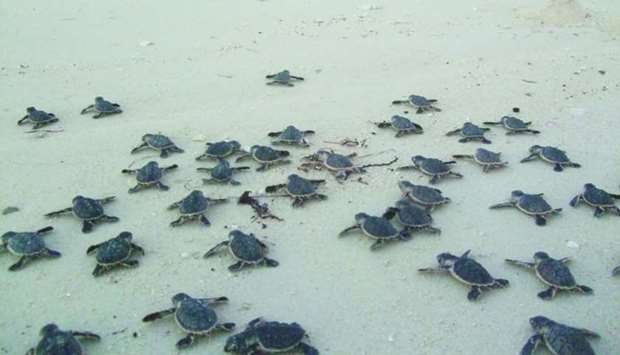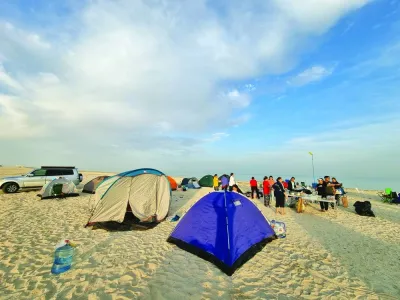The Environmental Science Centre (ESC) at Qatar University (QU) is focused on monitoring and protecting the hawksbill turtles that come to Qatar to nest each year. Staff at the ESC have been able to keep the monitoring effort similar to previous years during the height of Covid-19 lockdown precautions taken by the government, QU has stressed.





Nesting turtle

Tracker on the back of the turtle

Installation of a tracker

Morphological measurement
"We have noticed a change in nesting behavior this year among nesting turtles, possibly due to the Covid-19 restrictions on beach closures. The total number of turtles coming to Qatar to nest is roughly the same as previous years. But the big difference we have noticed is the beaches they are using to nest appears to have changed slightly," QU said in a statement.
Previously, Ras Laffan, Ras Rakkan and Umm Tais have had the majority of nests. However, this year, beaches like Al Maroona, Al Ghariyah and Fuwairit have seen huge increases in nesting activity, it notes.
Al Maroona and Al Ghariyah in particular have seen big gains in nesting activity. These increases could be due to the fact that these sites normally receive many visitors from April to June, which could have deterred nesting activity. However, this year, as public access has been restricted, turtles may have preferred nesting on these sites.
For the first time since the project’s inception, a protected turtle nest hatchery has been erected in Ras Laffan Industrial City. In recent years, nests on the site have been subject to considerable pressure from fox predation. As such, project partners that work on the site (Qatar Petroleum and the ESC) have taken the step to relocate and protect nests in a protected hatchery on site.
"So far, this has been extremely successful by eliminating fox predation. This measure can also show to other projects around the world that development and effective conservation can exist together," the statement points out.
A crucial part of marine turtle protection in Qatar is understanding where they go when they’re not on the beach nesting. To achieve this, the ESC deploys satellite trackers on post-nesting turtles each year. Many important areas have been identified offshore from the tracking data.
There appears to be three main home ranges for hawksbills that nest in Qatar. Many of them either migrate back towards the waters off Dubai, south off Mesaieed or west near the Hawar Islands.
This year, for the first time in the project history, ESC staff deployed a satellite tracker on a nesting turtle from Ras Rakkan Island. This is the first time this has been accomplished and will provide valuable information on the post-nesting movements of hawksbills.
So far, this turtle has been seen travelling northwest, which is not commonly seen from nesting turtles in Qatar. This may identify to researchers new foraging grounds or areas important to turtles in Qatar and the wider Arabian Gulf.
Dr Hamad al-Kuwari, director of ESC and head of the project said, “The centre has benefited from its accumulated experiences, research and scientific reports in an attempt to assess and know the numbers of hawksbill turtles annually and their places of spread around the Qatari peninsula and the waters of the Arabian Gulf through tracking them with satellite tracking devices.”
Dr Jassim al-Khayyat, the project’s executive director, stressed the need to preserve the environment and reduce negative practices, stating: “To protect eggs, prevent vehicles from travelling on sandy beaches and raise awareness through media outlets of the importance of protecting turtles, their eggs and their young in nesting and hatching seasons, and by involving community members in activities related to protection.”
Previously, Ras Laffan, Ras Rakkan and Umm Tais have had the majority of nests. However, this year, beaches like Al Maroona, Al Ghariyah and Fuwairit have seen huge increases in nesting activity, it notes.
Al Maroona and Al Ghariyah in particular have seen big gains in nesting activity. These increases could be due to the fact that these sites normally receive many visitors from April to June, which could have deterred nesting activity. However, this year, as public access has been restricted, turtles may have preferred nesting on these sites.
For the first time since the project’s inception, a protected turtle nest hatchery has been erected in Ras Laffan Industrial City. In recent years, nests on the site have been subject to considerable pressure from fox predation. As such, project partners that work on the site (Qatar Petroleum and the ESC) have taken the step to relocate and protect nests in a protected hatchery on site.
"So far, this has been extremely successful by eliminating fox predation. This measure can also show to other projects around the world that development and effective conservation can exist together," the statement points out.
A crucial part of marine turtle protection in Qatar is understanding where they go when they’re not on the beach nesting. To achieve this, the ESC deploys satellite trackers on post-nesting turtles each year. Many important areas have been identified offshore from the tracking data.
There appears to be three main home ranges for hawksbills that nest in Qatar. Many of them either migrate back towards the waters off Dubai, south off Mesaieed or west near the Hawar Islands.
This year, for the first time in the project history, ESC staff deployed a satellite tracker on a nesting turtle from Ras Rakkan Island. This is the first time this has been accomplished and will provide valuable information on the post-nesting movements of hawksbills.
So far, this turtle has been seen travelling northwest, which is not commonly seen from nesting turtles in Qatar. This may identify to researchers new foraging grounds or areas important to turtles in Qatar and the wider Arabian Gulf.
Dr Hamad al-Kuwari, director of ESC and head of the project said, “The centre has benefited from its accumulated experiences, research and scientific reports in an attempt to assess and know the numbers of hawksbill turtles annually and their places of spread around the Qatari peninsula and the waters of the Arabian Gulf through tracking them with satellite tracking devices.”
Dr Jassim al-Khayyat, the project’s executive director, stressed the need to preserve the environment and reduce negative practices, stating: “To protect eggs, prevent vehicles from travelling on sandy beaches and raise awareness through media outlets of the importance of protecting turtles, their eggs and their young in nesting and hatching seasons, and by involving community members in activities related to protection.”



